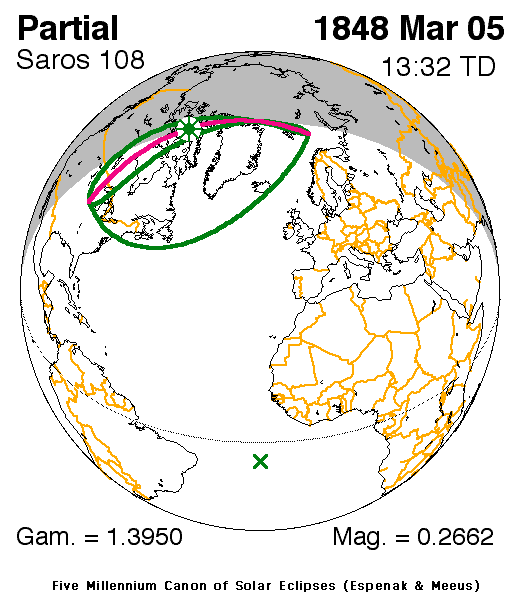|
Solar Eclipse Of January 21, 1852
A partial solar eclipse occurred at the Moon's Lunar node, descending node of orbit on Wednesday, January 21, 1852, with a Magnitude of eclipse, magnitude of 0.4577. A solar eclipse occurs when the Moon passes between Earth and the Sun, thereby totally or partly obscuring the image of the Sun for a viewer on Earth. A partial solar eclipse occurs in the polar regions of the Earth when the center of the Moon's shadow misses the Earth. It was first of three partial eclipses that took place that year within the space of nearly six months, the last one was in June 1852 in the same hemisphere with a very tiny portion in the same area with the previous eclipse but the remainder in South America. Description The eclipse was visible in almost the whole of Antarctica which had a 24-hour daylight with the exception of one part of the mid northernmost area of Antarctica by the Indian Ocean and around the area of the Antarctic Circle, a small piece of southernmost Tasmania with Hobart, Tasmani ... [...More Info...] [...Related Items...] OR: [Wikipedia] [Google] [Baidu] |
Solar Eclipse
A solar eclipse occurs when the Moon passes between Earth and the Sun, thereby obscuring the view of the Sun from a small part of Earth, totally or partially. Such an alignment occurs approximately every six months, during the eclipse season in its new moon phase, when the Moon's orbital plane is closest to Ecliptic, the plane of Earth's orbit. In a total eclipse, the disk of the Sun is fully obscured by the Moon. In #Types, partial and annular eclipses, only part of the Sun is obscured. Unlike a lunar eclipse, which may be viewed from anywhere on the night side of Earth, a solar eclipse can only be viewed from a relatively small area of the world. As such, although total solar eclipses occur somewhere on Earth every 18 months on average, they recur at any given place only once every 360 to 410 years. If the Moon were in a perfectly circular orbit and in the same orbital plane as Earth, there would be total solar eclipses once a month, at every new moon. Instead, because the Mo ... [...More Info...] [...Related Items...] OR: [Wikipedia] [Google] [Baidu] |

